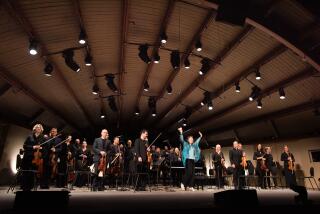Mozart in a Box: All the Symphonies
- Share via
As complete an edition of the complete Mozart symphonies (fragments are not included) as the composer’s big year is likely to produce has arrived in the gigantic form of a box containing 13 CDs (60021) on the German Capriccio label. Retail price: a whopping $180.
The set contains not only the canonic 41--the last-composed “Jupiter” bears that number--but a total of 55 works. Numbers following 41 are in fact all youthful creations, dating from the precocious composer’s teens or earlier.
The components of this thoughtfully realized project hail from a logical source and presumedly authentic traditions, the use of modern instruments notwithstanding: the Salzburg Mozarteum Orchestra under its Austrian music director, Hans Graf, who led the ensemble’s recent United States tour, which included several Southland stops.
Graf, who is in his early 40s--and whose first full-time conducting job was as music director of the Iraqi National Symphony in pre-Saddam Baghdad--emerges a dedicated, undogmatic, often insightful Mozartean.
He is as familiar with the latest performance practices, fads and wrinkles as anyone, but picks and chooses from among them. Graf disdains the use of keyboard continuo throughout, which leaves some aural gaps in the early works. Yet it is precisely here--in the first 20 symphonies, starting with the eight-year-old’s K. 16--that Graf’s wittily vigorous leadership and the Salzburgers’ alert responses pay the greatest dividends.
Happily, if quixotically, 11 of these juvenile treasures, in the identical performances, are available on a pair of Capriccio’s super-budget Laserlight CDs (15 867, 15 868). They’ll set you back about $5 per disc.
On the thorny subject of the pacing and articulation of minuets, Graf, while claiming to take them according to their individual needs rather than wholesale at currently sanctioned brisk tempos, comes down on the side of slow, if not heavy. A certain monotony-in-the-middle creeps in when slowish minuets follow relaxed slow movements, as is usually the case here.
In the outer movements, however, Graf’s bright pacing, sprung rhythms (the bass line never drags) and the cleanly etched wind/string balances he achieves are consistently winning.
Capriccio’s recorded sound gives us incisive woodwind tone and there is a pleasant feeling of air around the ensemble. Timpani presence is, however, lacking.
Perhaps the most purposeful, consistently satisfying Mozart symphonies being recorded these days come from Sir Charles Mackerras and the modern-instrument Prague Chamber Orchestra on the Telarc label.
The latest installments of this nearing-completion series offer the works numbered 14 through 18, K. 114, 124, 128-30 (Telarc 80242); 19-23, K. 132-34, 162, 181 (80217); and Nos. 32, K. 318, 35, K. 385 (“Haffner”) and 39, K. 543 (80203).
The buoyancy and clarity of Mackerras’ fast-paced interpretations--the minuets really fly--are constants, as is the sweetness of string tone that marks the slow movements.
Telarc’s sonics are as problematic as earlier in the series: Why use a smallish band to achieve clarity of texture and then place them in a huge hall which disperses their sound? That complaint registered, Mackerras’ Mozart remains highly recommended.
To Sir Thomas Beecham belongs much of the credit for expanding earlier audiences’ knowledge of the symphonies beyond the final Big Six.
EMI/Angel’s handsome remasterings of his late-1930s editions with the London Philharmonic of the then-barely known Nos. 29, 31, 34 as well as the last six (63698, 3 mid-priced CDs) display articulation sufficiently springy to gladden the hearts even of period specialists. The snail’s-pace opening movement of No. 29 is an obvious exception.
Beecham’s lumpy minuets are unlikely to satisfy today’s listener, but it requires no act of extreme tolerance to respond elsewhere to the lively intelligence and grace of the conductor who did more to foster Mozart-love in our century than any other.
By curious contrast, a just-recorded pairing of K. 543 and the “Jupiter” by the venerable (and lately venerated) German conductor Gunter Wand and his North German Radio Orchestra sounds positively antediluvian from a stylistic standpoint (RCA 60714). Wand’s tempos are hardly slower than Beecham’s, but strings and upper winds are so weighted down by the bass that they not only fail to soar but seem stuck in mud.
Unfortunately, Wand, one of our foremost Bruckner interpreters, projects--inadvertently, we assume--a relationship between two disparate, irreconcilable Austrian masters.
More to Read
The biggest entertainment stories
Get our big stories about Hollywood, film, television, music, arts, culture and more right in your inbox as soon as they publish.
You may occasionally receive promotional content from the Los Angeles Times.










